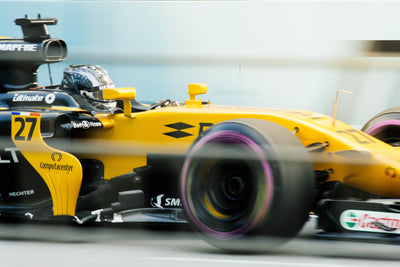Domestic US orders.

The Difference Between Motorcycle Helmets and Racing Helmet
By Matt Lambert at Right Motorsport
Introduction
Helmets are essential for protecting drivers' and riders' heads, but not all helmets are created equal. When it comes to motorsport and motorcycle riding, there are significant differences between the helmets used in each discipline. While their purposes may be similar, motorcycle helmets and motorsport helmets are purpose-built for their respective environments.
Let's delve into the distinctive features and functions of these helmets and explain why motorsport and motorcycle helmets are differnt and should never be mixed.
Auto Racing or Motorsport Helmets and SA Certification
Auto racing helmets are subject to rigorous testing and certification by the Snell Memorial Foundation, denoted by the "SA" certification. SA in this instance stands for "Special Application," and the most current version of this is SA2020.
SA-rated helmets undergo a series of tests that exceed the standards set by regulatory bodies like the UN ECE and DOT. These tests evaluate factors such as impact resistance, penetration resistance, flame resistance, and retention system strength.
The SA certification ensures that the helmet is specifically designed for auto racing, providing the highest level of safety and protection for drivers in high-speed, high-impact scenarios.
To illustrate, the Snell SA2020 homologation label will look like the one in the picture below.

Motorcycle Helmets and Snell/M2020 Certification
Motorcycle helmets also adhere to Snell standards, with the latest being M2020. While Snell's testing methods align with UN ECE and DOT standards, they include additional stringent criteria.
Motorcycle helmets undergo a range of tests to ensure they meet the necessary safety requirements for riders. These tests evaluate impact resistance, penetration resistance, retention system strength, and field of vision. The UN ECE 22.05 standard guarantees that the helmet provides adequate protection for motorcycle riders in various scenarios, including crashes and impacts.
To illustrate, the Snell M2020D homologation label will look like the one in the picture below.

Example of Snell M2020 Holologation Label for Motorcycle Helmets
Key Differences Between Motorcycle and Auto Racing Helmets
Fire Proofing: The main crucial difference between motorcycle and motorsport helmets is the requirement for fire rating in the latter. Auto racing helmets undergo fire testing due to the possibility of drivers being trapped inside burning cars.
The interior fabric of car racing helmets tends to be Nomex, a fire-resistant material that can withstand high temperatures. Furthermore, some motorsport helmets have been designed so that the rubber seal around the visor area will deform under intense heat, bonding the lens to the helmet.
In contrast, motorcycle riders generally fall away from burning wreckage, consequently, motorcycle helmets prioritize other features such as impact absorption, ventilation, and comfort, without the need for fire-retardant materials.
Impact Absorption: Another significant difference lies in the types of impacts that motorcycle helmets and auto racing helmets are designed to handle. Motorcycle helmets must not only protect against direct impacts but also contend with abrasion resulting from sliding. In motorcycle accidents, riders may be thrown from their bikes and slide along the road surface, subjecting their helmets to friction and scraping.
In contrast, auto-racing helmets primarily focus on protecting the head from direct impacts within the confines of a racing vehicle. The head may come into contact with the roll cage, steering wheel, side window, or roof (in case of a rollover), but sliding impacts are less common.
Vision: You may have noticed that motorcycle helmets tend to be fitted with very large front visors. This is so that as the rider leans forward, they can look up towards the road, giving them extended visibility when tucked behind the bike's windscreen.
Motorsport helmets generally are the complete opposite, with very thin visors in comparison. The thinner visor helps narrow the driver's vision, focusing on the road, and most importantly, helps block sunlight or glare reach your eyes. It is not very often during a race that a driver must look up.
The visors are probably the most noticiable difference between the two types of helmets as you can see in the illustrative pictures below.
 Example of Motorsports Helmet, Bell K1 Pro Auto Racing Helmet
Example of Motorsports Helmet, Bell K1 Pro Auto Racing Helmet

Zamp FS-9 Graphic M2020D & DOT Certificed Motorcycle Helmet
HANS Device: All SA-rated motorsport helmets since SA2015 are fitted to be compatible with a HANS (Head and Neck Safety) device. The HANS device is a vital (and often mandatory) safety feature in motorsport that helps restrict head movement under large impacts.
On motorcycle helmets, however, the HANS device would be counterintuitive for motorcycle riders. Motorcycle riding involves a different posture and more head movement compared to driving a car. Riders need the flexibility to move their heads around to maintain situational awareness and navigate through traffic effectively. Therefore, motorcycle helmets do not incorporate provisions for HANS devices.

Driver Wearing a Racing Helmet and Hans Device
Conclusion
Motorcycle helmets and motorsport helmets serve different purposes and are designed to meet the specific needs of their respective disciplines. Using one helmet for the other discipline is not recommended.
While there may be certain motorcycle helmets that meet motor racing standards, it is essential to use the appropriate helmet for each activity. Safety should always come first, and that starts with the right gear for the job. Whether you're tearing up the racetrack or cruising on two wheels, choose a helmet that is specifically designed for your chosen activity. Protect your head and ride with confidence.




Leave a comment